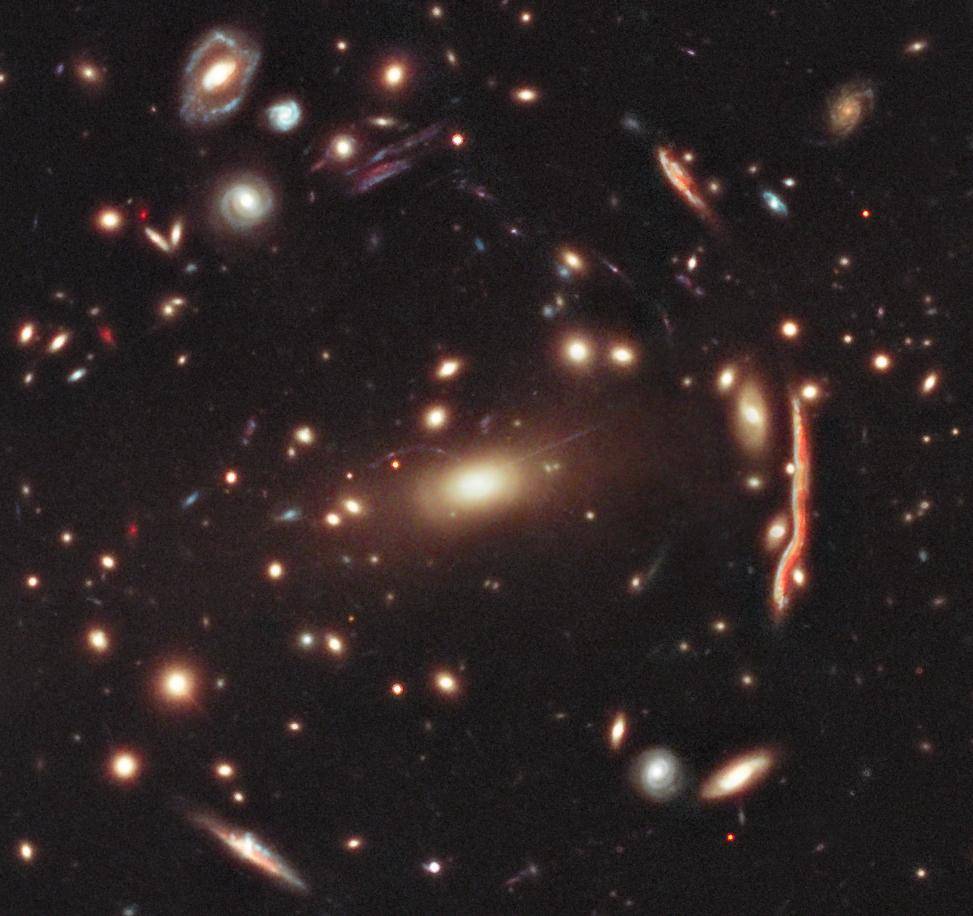AstroFan: The Spooky Case of Dark Matter

Header Image: The distorted shapes in the cluster shown here are distant galaxies, from which the light is bent by the gravitational pull of dark matter within the cluster of galaxies. Image Credit: NASA, ESA, M. Postman (STScI), and the CLASH Team
Greetings fellow astro-fans! Halloween is almost here, and as you know, it is a time to celebrate all things spooky, mysterious, and unsettling.
For this month’s AstroFan, I thought that it would be apropos for us to take a look at one of the most unsettling mysteries in the known Universe.
Dark Matter.
So sit back, grab some candy, and read on to learn more about why scientists are so perplexed about this common fixture of our Universe.
Discovering Dark Matter
The story about how dark matter was discovered reads like an epic mystery novel!
In the 1930s, a Swiss astrophysicist named Fritz Zwicky noticed something rather odd about the cluster of galaxies—the Coma Cluster to be exact—that he had been observing.
The galaxies were revolving through the cluster much faster than expected, especially near its outer regions. In fact, the galaxies were moving at such high speeds that the gravity around them should’ve become ineffective at keeping them from drifting away from one another.
Something, was keeping the galaxies clustered together.
Zwicky concluded that there had to be an unseen mass that served as a source for additional gravity, keeping the Coma Cluster from dispersing away.
And thus the concept of dark matter was born!
It wasn’t until the 60s and 70s that Zwicky’s observations were further expanded upon, by a young astronomer named Vera Rubin.
Using observations made about the orbits of stars within a single galaxy, Rubin was able to conclude that on average, galaxies contain about 10 times as much mass compared to what visible stars account for.
Initially, many astronomers were skeptical of these findings, but eventually, the evidence proved to be so overwhelming that the existence of dark matter became widely accepted in the space-science community.
So, What Is It?!
I bet you’re wondering what exactly is dark matter?
The chilling answer is that we don’t really know.
You see, studying dark matter is a bit of a difficult task due to the fact that it is completely invisible and undetectable with the use of modern-day astronomical instruments.
Here’s a fun fact: Adler astronomer, Dr. Geza Gyuk, has done extensive research regarding dark matter.
In the mid-90s, Dr. Geza and a group of scientists studied a specific subset of celestial objects called MACHOs.
MACHOs, also known as Massive Compact Halo Objects, are dense objects that emit little to no light. Some examples include: black holes, neutron stars, and brown dwarfs.
Since MACHOs are simultaneously dense and not very luminous, it was originally thought that they could be a serious contender for dark matter.
However, the research conducted by Dr. Geza and his crew revealed with confidence that MACHOs were most likely not the cause of dark matter. There simply weren’t enough of these objects to account for the huge amounts of unknown mass throughout the Universe.
But fret not, although Dr. Geza’s MACHOs research didn’t solve the mystery of dark matter, it did help narrow down some of the potential answers. To quote Dr. Geza: “If you can rule out the possibilities with an experiment, that’s a good thing too.”
So, if MACHOs aren’t behind dark matter…then what could it be?!
Well, most scientists believe that dark matter is composed of some sort of “exotic particle” that doesn’t interact with baryonic matter. Baryonic matter is the matter that you and I interact with on a daily basis—the kind of matter that is composed of protons, neutrons, and electrons.
According to Dr. Geza, a good candidate for dark matter can be found in WIMPS—aka Weakly Interacting Massive Particles.
WIMPs are hypothetical particles that make up a specific kind of dark matter, Cold Dark Matter (CDM). (CDM is a type of dark matter that moves slowly compared to the speed of light.)
These proposed WIMPs barely interact with baryonic matter and they also don’t emit light, making them exceedingly difficult to observe in experiments.
What’s Next
Nearly a century after Fritz Zwicky’s observations, the search for CDM and WIMPs continues to rage on.
Whether through observing dark matter’s effects on celestial objects or trying to capture a non-baryonic particle in the lab—scientists are as eager as ever in their attempts to solve this mystery.
When asked about the future of dark matter research, Dr. Geza had this to say: “We’re hoping that the next generation of experiments will start to detect these non-baryonic particles…If they don’t…people will start to get worried.”
There you have it folks! You can now begin to understand just how unsettlingly mysterious dark matter currently is for those who study it.
With this in mind, as you celebrate all things spooky—swamp monsters, aliens, and the like—don’t forget about the spookiest beast of them all…dark matter.
Stay tuned for more awesome space facts on the next AstroFan.
Thank you for reading!
—Bianca, a.k.a. AstroFan
A special thanks to Adler astronomer Dr. Geza Gyuk for providing information about dark matter!






